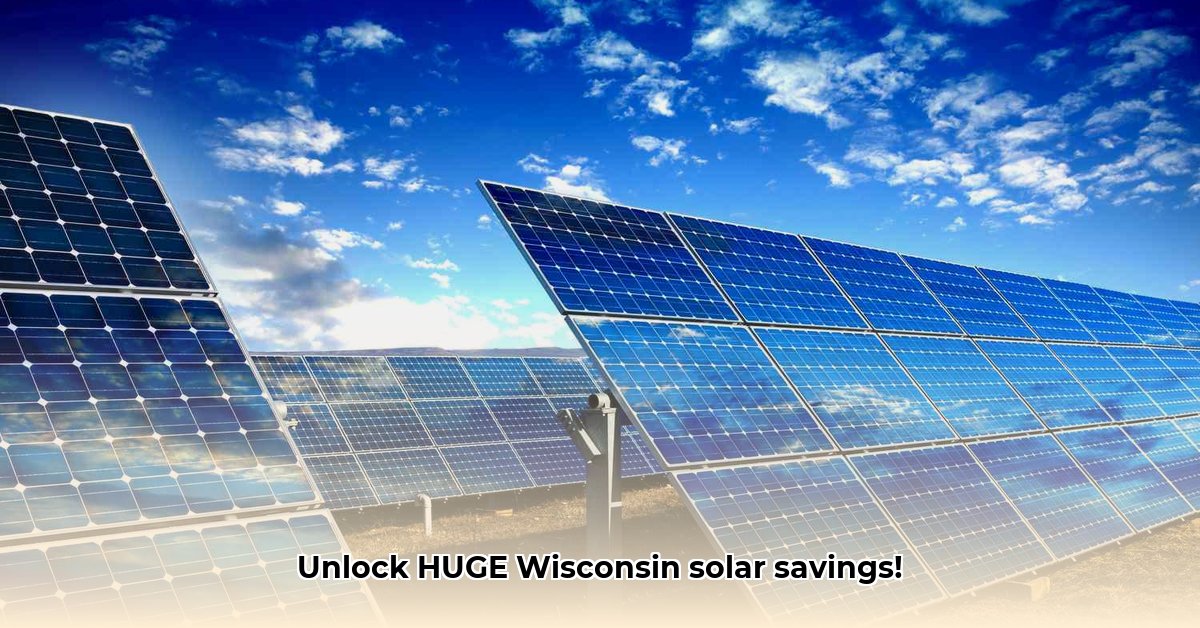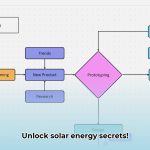Is solar power right for your Wisconsin home? This comprehensive guide simplifies understanding solar incentives, choosing the best panels, and finding a reliable installer. Learn how to calculate savings, navigate financing, and maximize your return on investment, empowering homeowners and solar professionals to harness Wisconsin’s solar potential.
Solar Energy in Wisconsin: A Path to Savings and Sustainability
Switching to solar energy in Wisconsin is a significant step toward reducing energy bills and contributing to a cleaner environment. While the initial investment can seem substantial, the state and federal incentives available make solar power an increasingly accessible and financially attractive option for Wisconsin residents.
Decoding Wisconsin’s Solar Incentives
Maximizing your savings requires understanding the available incentives. The cornerstone is the federal solar Investment Tax Credit (ITC), which offers a 30% tax credit on the cost of your solar system through 2032. This credit dramatically reduces upfront expenses.
Wisconsin also offers several state-level incentives. A property tax exemption ensures that your property taxes won’t increase due to the added value of your solar panels. Additionally, a sales tax exemption eliminates the 5% sales tax on solar panel installations, saving homeowners hundreds of dollars. Net metering allows you to sell excess solar energy back to the grid, further reducing your electricity bills and potentially generating income. Finally, the Focus on Energy program provides cash rebates for eligible solar installations, with amounts varying based on location and system size.
These incentives can be thought of as powerful tools that significantly lower the cost of solar energy, making it a viable and smart investment for Wisconsin homeowners.
A Step-by-Step Guide to Going Solar
Ready to take the plunge? Here’s a streamlined approach:
- Obtain Multiple Quotes: Reach out to several reputable solar installers in Wisconsin for customized quotes. Aim for at least three to compare pricing, equipment options, and service offerings. Don’t hesitate to ask for references and read online reviews from previous customers.
- Calculate Energy Needs: Analyze your household’s electricity consumption using your utility bills. This information will help determine the appropriate size of your solar system, ensuring you generate enough power to meet your needs without overspending.
- Explore Financing Options: Research available financing options, including solar loans, leases, and power purchase agreements (PPAs). A loan allows you to own the system outright, while a lease or PPA involves paying for the electricity generated by a system owned by a third party. Carefully evaluate the pros and cons of each option based on your financial situation and long-term goals.
- Project Savings: Before committing, calculate your estimated savings, factoring in all applicable incentives and your energy consumption patterns. Most installers can provide detailed financial projections to help you assess the return on investment and payback period.
- Installation & Monitoring: Once your system is installed, monitor its performance regularly using the provided monitoring tools. Many installers also offer maintenance plans to ensure optimal system operation and address any potential issues.
Expected ROI: A Realistic Perspective
The return on investment for solar in Wisconsin varies depending on factors such as system size, energy consumption, and location. While most estimates suggest a payback period of 7 to 11 years, remember that solar energy offers benefits beyond simple financial returns. Reducing your carbon footprint and achieving energy independence are valuable assets.
Navigating Challenges: Potential Risks and Mitigation Strategies
Even with careful planning, unexpected challenges can arise. Anticipating these potential issues and having mitigation strategies in place can help ensure a smooth and successful solar journey.
| Risk Factor | Likelihood | Impact | Mitigation Strategy |
|---|---|---|---|
| Federal Tax Credit Changes | Moderate | High | Act promptly to take advantage of existing incentives before potential reductions or expirations. |
| Unexpected Energy Usage Changes | Moderate | Medium | Account for future energy needs (e.g., electric vehicles, heat pumps) during system sizing. |
| Net Metering Policy Changes | Low | Medium | Stay informed about policy updates from your utility company and advocate for favorable net metering policies. |
| Installer Issues | Low | High | Thoroughly research and vet installers, checking references, licenses, and insurance. |
| Equipment Problems | Low | Medium | Choose reputable installers who offer robust warranties on both equipment and installation workmanship. |
| Roof Condition and Suitability | Medium | High | Prior to solar panel installations, have a professional roofer inspect the roof’s condition and suitability. |
The Future of Solar Power in Wisconsin
Wisconsin’s solar energy landscape is dynamic, with ongoing advancements in technology and evolving policies. Staying informed about emerging trends and policy changes is crucial for maximizing the benefits of solar energy.
Take Control of Your Energy Future
Don’t let initial costs deter you from exploring solar energy. With careful planning, a thorough understanding of available incentives, and a qualified installer, you can harness the sun’s power to save money, reduce your environmental impact, and contribute to a sustainable future for Wisconsin.
Wisconsin Solar Incentives: Your Path to the Fastest ROI
Are you considering solar panels in Wisconsin but concerned about the cost? Unlocking Wisconsin’s solar incentives is key to achieving the fastest return on investment. Understanding these incentives can significantly lower your initial investment and accelerate your payback period.
Understanding the Solar Incentive Landscape in Wisconsin
Wisconsin boasts a combination of federal and state incentives designed to make solar energy more accessible. Knowing how these incentives work and how they interact is key to maximizing your savings.
Decoding the Federal Investment Tax Credit (ITC)
The federal ITC is the most significant incentive available, reducing your federal tax liability by 30% of your solar system’s cost. This substantial credit is available through 2032, providing a significant upfront cost reduction. Claiming the ITC requires careful tax planning, so consulting a tax professional is highly recommended.
Leveraging State-Level Incentives
Wisconsin offers several state-level incentives that complement the federal ITC. Sales and property tax exemptions on solar installations further reduce your costs. The sales tax exemption saves you 5% on the purchase price, while the property tax exemption ensures your property taxes won’t increase due to the added value of your solar panels.
Understanding Net Metering Policies
Net metering allows you to sell excess solar energy back to your utility company, generating credits on your electricity bill. However, net metering policies vary among utilities in Wisconsin. Research your utility’s specific policies to understand the buyback rate and any limitations on system size. Optimizing your system size to maximize net metering benefits can significantly impact your ROI.
Maximizing Savings with Focus on Energy
Wisconsin’s Focus on Energy program offers additional rebates for solar installations. Rebate amounts vary by location and system size, so checking your eligibility is essential. These rebates can further reduce your upfront costs and shorten your payback period. What are the exact details of the Focus on Energy Program?
System Size Optimization: Striking the Right Balance
While larger systems maximize the ITC benefit, rebates from Focus on Energy may have system size limitations. Carefully consider your energy consumption patterns, available roof space, and budget to determine the optimal system size for your needs. Balancing the size of the system is essential for an optimized ROI.
Roadmap to Solar Success in Wisconsin
- Research and Compare: Research all available incentives and compare quotes from multiple installers.
- Tax Consultation: Consult with a tax professional to ensure you correctly claim all applicable tax credits.
- Monitor Usage: Track your energy consumption and monitor your system’s performance.
- Plan for Expansion: Consider future energy needs and plan for potential system expansion.
- Incentive Claiming: Understand the claiming process for all incentives to maximise returns.
Achieve the Fastest ROI on Your Investment
Maximizing your ROI involves careful planning and a thorough understanding of Wisconsin’s solar incentive landscape. By diligently researching, strategically planning your solar system, and taking advantage of all available incentives, you can significantly boost your savings and achieve the fastest possible return on your investment in solar energy.
Wisconsin Solar Panel Options: Choosing the Right System for a Diverse Roof
Harnessing solar power in Wisconsin offers remarkable potential for savings. With favorable incentives, switching to solar energy can significantly reduce your energy bills. However, selecting the right solar panel system for your specific roof type is crucial for maximizing energy production and ensuring a reliable installation.
Evaluating Your Roof’s Suitability for Solar Panels
The first step in choosing the optimal solar panel system is to assess your roof’s suitability. Factors to consider include:
- Orientation: South-facing roofs generally receive the most sunlight in Wisconsin, maximizing energy production. However, east- and west-facing roofs can also be viable options.
- Angle: The optimal roof angle for solar panels in Wisconsin is typically between 30 and 45 degrees.
- Shading: Obstructions such as trees, chimneys, and neighboring buildings can cast shadows on your roof, reducing solar panel output.
- Material: Different roofing materials, such as asphalt shingles, metal, tile, and wood shakes, require different mounting systems.
- Age and Condition: Older roofs might need repairs or replacement before solar panel installation.
A professional solar installer can conduct a thorough site assessment to evaluate these factors and determine the best panel system for your roof.
The Main Types of Solar Panels for Wisconsin Homes
- Monocrystalline Panels: Known for their high efficiency and sleek black appearance, monocrystalline panels generate more power per square foot, making them ideal for roofs with limited space. They are also more expensive than other options.
- Polycrystalline Panels: Polycrystalline panels are more affordable than monocrystalline panels. They are still highly efficient and offer a good balance between cost and performance.
- Thin-Film Panels: Thin-film panels are flexible and lightweight, making them suitable for unconventional roof shapes and materials. They are generally less efficient than crystalline panels, requiring more roof space to generate the same amount of power.
Your specific needs and roof characteristics will determine the best panel type for your home.
Navigating Solar Incentives + Regulations in Wisconsin
Wisconsin offers various financial incentives to encourage solar adoption, including federal tax credits, state tax exemptions, and net metering programs. Understanding these incentives is crucial for maximizing your savings. A qualified solar installer can guide you through the application process and help you navigate any relevant regulations. Wisconsin’s DNR provides resources.
Selecting the Right Solar Installer
Choosing a reputable and experienced solar installer is crucial for a successful installation. Look for installers with a proven track record, positive customer reviews, and proper licensing and insurance. A knowledgeable installer will assess your roof, recommend the best panel system for your needs, handle permitting and installation, and provide ongoing maintenance and support.
External Resources
Resources : Wisconsin Department of Natural Resources, Solar Installation Guide
Financing Strategies for Solar Investments in Wisconsin
Solar energy is becoming increasingly attractive in Wisconsin, offering long-term cost savings and environmental benefits. Finding the right financing strategies for Wisconsin solar investments is essential to making this transition affordable and accessible.
Understanding Your Investment Options
The upfront costs of installing a solar system can be significant, but various financial strategies can help reduce the financial burden and make solar energy a reality for more Wisconsin residents.
Financing Mechanisms
- Direct Purchase: Paying cash for your solar system provides immediate ownership and maximizes long-term savings. However, it requires a substantial upfront investment.
- Solar Loans: Securing a solar loan from a bank, credit union, or specialized lender allows you to spread the cost over time. Look for loans with competitive interest rates and flexible repayment terms.
- Leases and Power Purchase Agreements (PPAs): These options involve a third party owning the solar system and selling you the electricity it generates. Leases typically involve fixed monthly payments, while PPAs charge you based on the amount of electricity produced.
- Community Solar: Investing in a community solar project allows you to share the benefits of solar energy without installing panels on your own roof. You typically purchase a share of the project and receive credits on your electricity bill.
- Government Grants and Rebates: Explore available federal, state, and local grants and rebates to offset the cost of your solar investment.
Navigating Wisconsin’s Regulations
Wisconsin’s regulatory environment plays a crucial role in shaping the financial viability of solar projects. Understanding state incentives, net metering policies, and permitting requirements is essential for maximizing your return on investment.
ROI Maximization
The time it takes to recoup your solar investment depends on various factors, including the size of your system, your energy consumption, and the financing option you choose. A well-designed system, combined with available incentives, can significantly reduce your electricity bills, leading to a substantial long-term return.
Roadmap to Solar Investment
- Assess Energy Needs: Evaluate your current energy consumption to determine the right system size.
- Explore Financing: Compare loans, leases, PPAs, and community solar options.
- Find an Installer: Seek quotes from several installers and check license and warrantees.
- Incentive Applications: Benefit from federal, state and local solar programs.
- System Monitoring: Follow energy production to guarantee efficiency.
Risk Mitigation
| Risk Factor | Mitigation Strategy |
|---|---|
| Regulatory Shifts | Track policy changes and communicate with local authorities. |
| Financing Challenges | Explore options and build a robust financial plan. |
| Public Perception | Educate and attend to public concerns. |
| Technical Issues | Rely on trusted companies and experienced technicians. |
| Environmental Concerns | Promote sustainable production practices. |
With careful planning and an understanding of the available financing strategies for Wisconsin solar investments, you can unlock significant savings, reduce your environmental impact, and contribute to a sustainable energy future.
- Choosing the Right Portable Hydro Turbine for Your Needs - December 14, 2025
- Best Portable Hydro Generators for Off-Grid and Outdoor Power - December 13, 2025
- Choosing the Right Generator with Water for Off-Grid Power - December 12, 2025
















